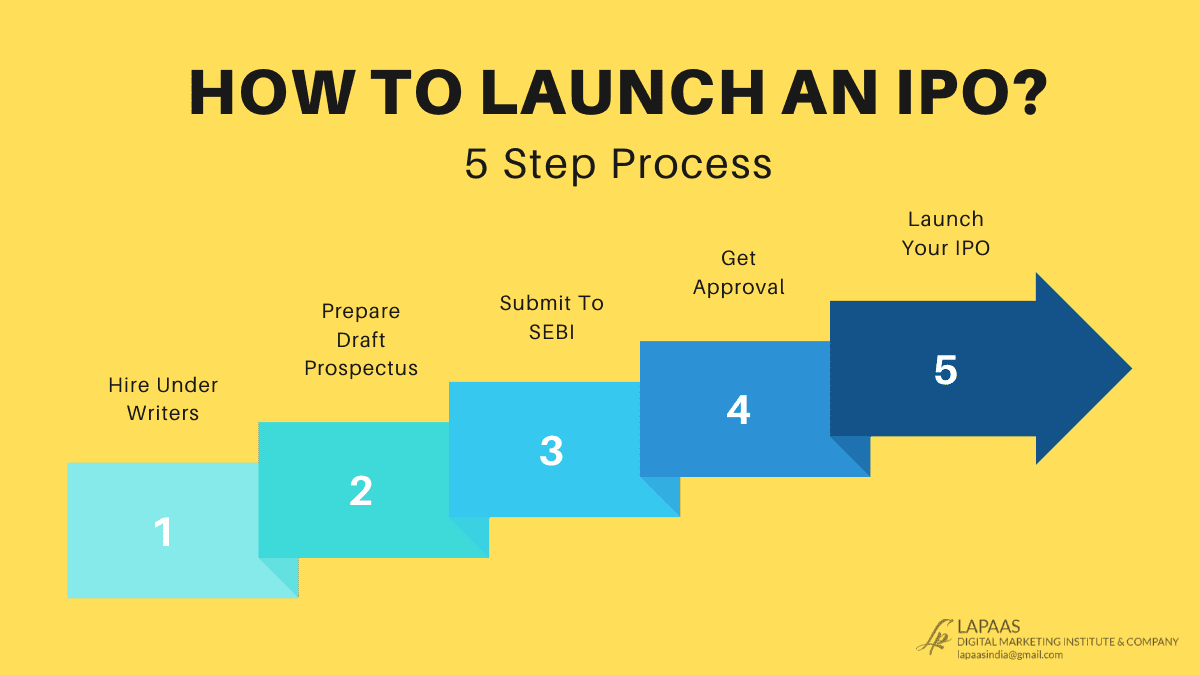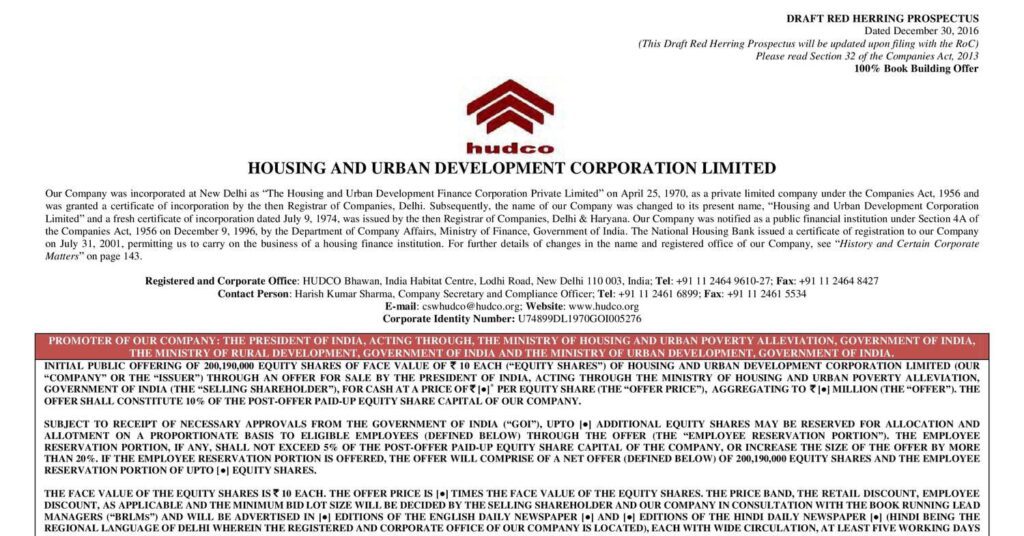Then you can raise money from Initial Public Offer (IPO).
Initial Public Offer is the best way to raise money if you want to grow your venture.
IPO is an offer in which the company goes Public from private means In Private limited company only some people have ownership of the company but in public offer anyone can buy the ownership of Company.
A lot of people want to raise money through IPO Process but they don’t know how to launch IPO or what is the process of IPO in India So in today’s blog we will discuss everything you need to know regarding IPO For Example How to launch IPO & Process of IPO in India
So in Today’s blog, we will discuss The process and requirements to launch an Initial Public Offer.
What’s in it for me
What is IPO
IPO stands for Initial Public Offering. IPO is a process in which a Private company sells her share to the public for the first time. After Becoming a Public limited company the share of a company can trade on Different Stock Exchanges. Thus Initial Public Offer is the process to become a Public Company from a Private Company.
Advantages Of IPO
- The number of benefits of launching an IPO is that you can raise a lot of money for the Company.
- IPO gives your company more Public Exposure. When your Company listed on Stock Exchanges this will reach a lot of people. So it will give your company more publicity.
- IPO also reduces the cost of Capital because in Publically raised money you don’t have to pay the interest to anyone.
- Initial Public Offer also provides an opportunity for existing Stakeholders to take existing.
- After Becoming a public limited company it becomes easy to do mergers and acquire other companies.

Disadvantage Of IPO
- It will take a lot of time to issue Initial Public Offer. It will take 6 months to 1 year for launching an IPO.
- After Becoming a Public limited company you have additional regulatory and disclosure.
- It will pressurize your company to gain more profits.
- IPO Involves a cost you have to pay underwriter fees & audit fees etc. So it also very costly.
- In IPO, the share will be given to the public. So there is also a risk of losing potential control.
Cost Of IPO
IPO is a costly process. If you want to launch Your IPO you have to bear a lot of expenses. Firstly have to pay underwriters’ fees. Underwriters fees depend on the size of the Company and the risk profile of the company.
It also depends on the total value of the IPO. Underwriters fees will be somewhere between 2.5% and 5% of IPO Value. After paying underwriters fees you also have to pay An Audit fee. There is also a fee of listing on Stock Exchanges. These fees will 50000 or more than 50000. It depends on the paid-up capital of the company. There is also a yearly fee of listing.
Requirement of IPO
There are two ways to prove your eligibility for an IPO. If you can not eligible through the first requirement then you can select an alternative
Eligibility Criteria- Norm I
- Net Worth of Company should be 3 Crore in the previous full 3 years.
- The Company must have a tangible asset of 3 crores in the previous three years in which not more than 50% in monetary asset
- At Least 15 crore average profit before tax for the previous 3 years out of 5 years
- When companies want to launch its IPO for the first time then the size of IPO is not more than 5 times of It pre worth valuation.
- In A Case of Change the Company, then the minimum 50% of the revenue should become for preceding one year from the activity denoted by New Game
Eligibility Criteria- Norm II
The companies who want to raise a large capital or failed to lay down any step of above, then SEBI provides another alternative. Another route is book building route in which 75% of Net offer allowed to the company is mandatory allotted to Qualified Institutional Buyers (QIBs)

How To Launch IPO or Process of IPO in India
So here is the complete process to launch An IPO
1. Hire an Investment Bank
Any company that wants to launch an IPO has to go to the Investment banker.
It also could be a lead manager, underwriter or merchant banker. There can be more than 1 investment banker.
These investment bankers will collect all the required information about the Company. They will analyze the state of the company and know What amount of company need and all the relevant information.
Thus after collecting the relevant details an agreement will be signed by the company and underwrites in which they mention all the details like how much amount will be raised and how much they charge for the whole process etc.
In Some cases, underwriters make a promise to subscribe at least a fixed percentage of unsubscribed Shares on some term and condition basis.
It depends on the underwriters whether they promise or not. Let’s understand this by an example A Company want to issue 10000 share to the public and an agreement is signed between underwriter and company that underwriters will provide a guarantee to subscribe least 50% share i.e 5000.
If the public didn’t subscribe to the 5000 share underwriters will buy the remaining shares.
Underwriters will also make a draft prospectus.
A prospectus is a document issued by a company when they want to launch an IPO. In Prospectus all the details related to IPO will be mentioned.

2. Filled The Regulatory With the SEBI
When Draft prospects are ready and finalized with Company. Copywriters filled the SEBI the regulatory with the SEBI.
They will send this draft prospects to the SEBI for Review. SEBI stands for the Security Exchange Board of India who will regulate the Indian Markets and all the works related to Stock Markets.
The Draft Prospect must be sent to the SEBI at least a 30 day prior. The Draft prospect is only made when the Company wants to raise more than 50 lakh Rupees if they don’t want to raise more than 50 lakh they don’t need to prepare a draft prospectus.
When Draft Prospectus is submitted to the SEBI, Then SEBI will check all the details and give Suggestions to change within 30 days.
If all the details Are good The SEBI Will upload it to the website for public Review. If all the things are not good then SEBI Will give their suggestion and Then the company again needs to file Draft prospects with the correction commented by SEBI.

3. Listing Application To Stock Exchanges
When a draft prospect is submitted to the SEBI meanwhile the company can apply to Stock Exchanges to list their Socks.
There are 24 stock exchanges are available in India, But NSE (National Stock Exchange of India ) and BSE (Bombay Stock Exchange of India are the most popular Stock Exchanges in India.
There are also eligibility criteria for Listing Company on NSE.
For List, your Company on NSE the minimum paid-up capital of the company must be 10 crores and the capitalization of the Applicant’s equity shall not be less than 25 crores.
4. Road Show- Promotion Of IPO
When a draft prospectus is submitted to the SEBI, meanwhile companies are eligible to do the Promotion of their IPO. Companies do marketing and advertising of the IPO with the help of marketing agencies. It is Called the Road Show. All these marketing agencies are also regulated by SEBI.
5. Price of Share
Deciding the price of the share is an important factor in the IPO process. There are two ways to Price the share
I Fixed Price Offer
In Fixed Price Offer companies offer a fixed price of share like 1000 share at par rate of 10.
If companies want to issue their price at a fixed price, then the price should be mentioned in the draft prospectus as well as in the final prospectus.
II Book Building Offer
When the company didn’t want to offer the price at a fixed price they can offer a band of minimum and maximum bid price.
In these cases, Red Herring Prospectus is submitted in place of Draft Prospectus.
In these cases, the final prospectus is submitted to SEBI After the allocation of shares.
6. IPO Launching
On the date mentioned in the prospectus. IPO will be live for the Public to Apply for shares. IPO is available for applying for 3-6 days.
I hope you got everything you need to know about how to launch an IPO or Process of IPO Indian in this blog. If you have any doubts regarding how to launch IPO or Process of IPO in India you can ask us in the comment section
FAQs
There are mainly two main reasons to launch an IPO is to raise capital and to enrich prior investors. By going public, your firm gets access to a ton of investment opportunities.
IPO is simply the shares of stock issued by a company to the public for the first time. Its full form is Initial Public Offering. IPO’s main purpose is to give a part of the ownership of the company to the relevant investors in return for money/investments in your company.
1. Hire an Investment Bank
2. Filled The Regulatory With the SEBI
3. Listing Application To Stock Exchanges
4. Road Show- Promotion Of IPO
5. Price of Share
6. IPO Launching



